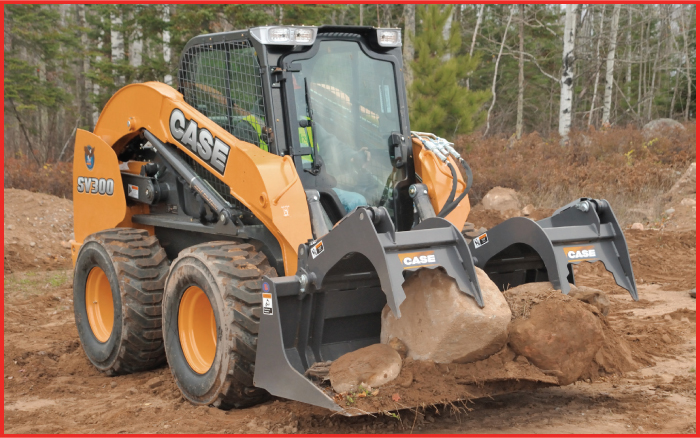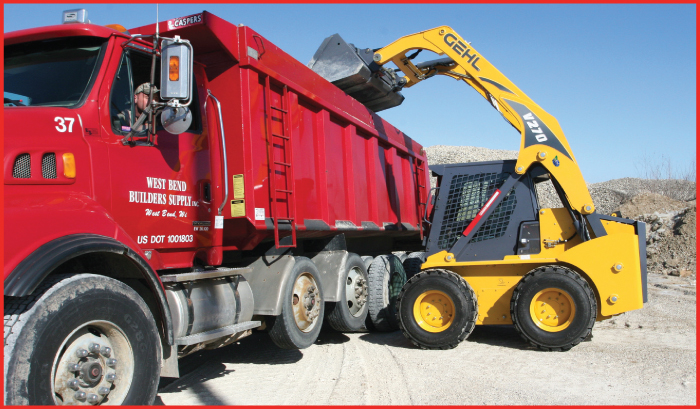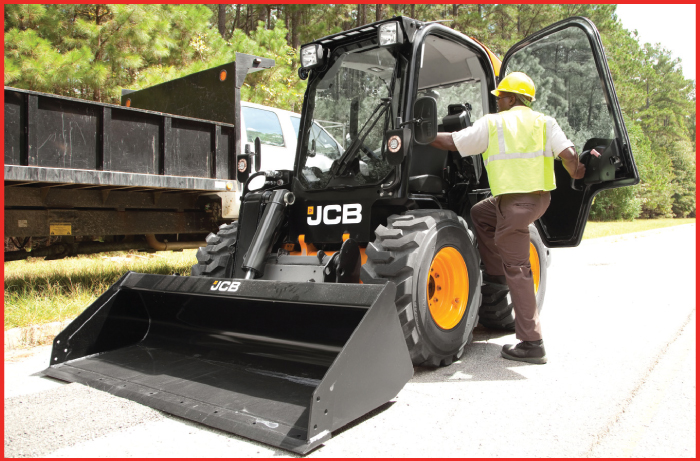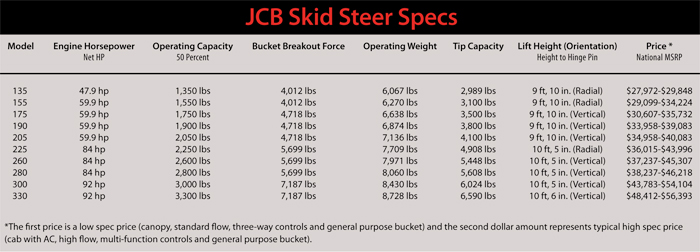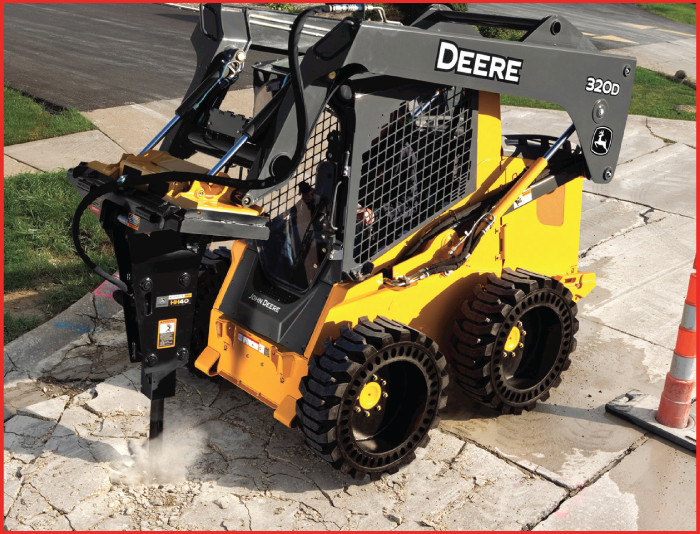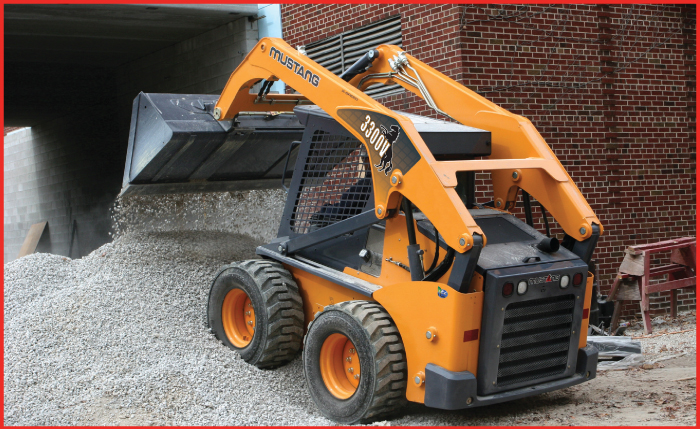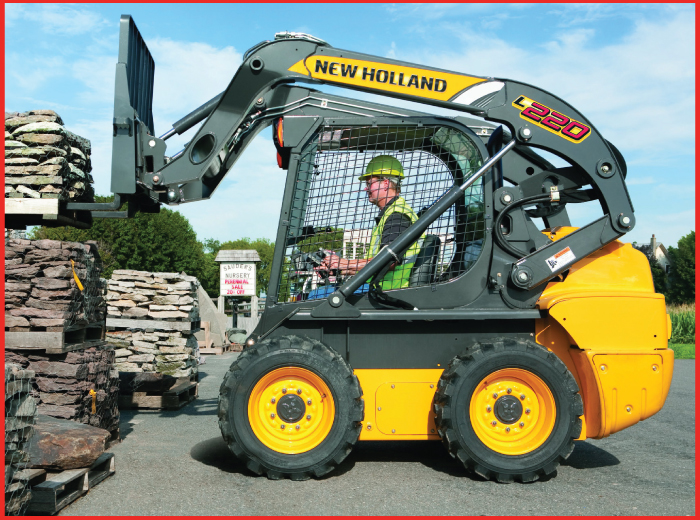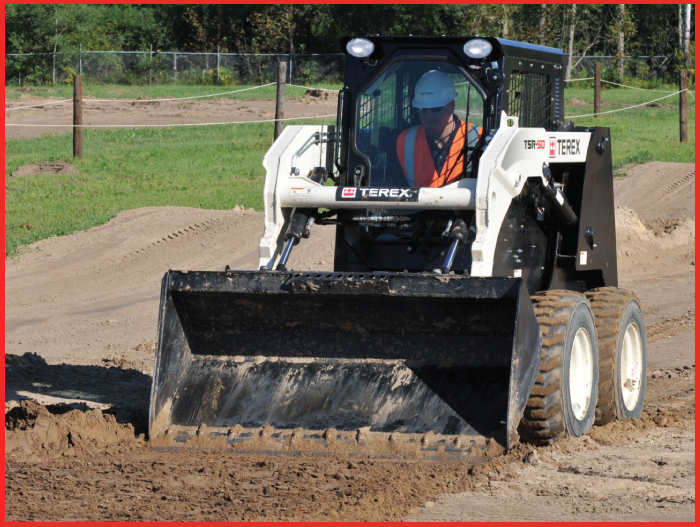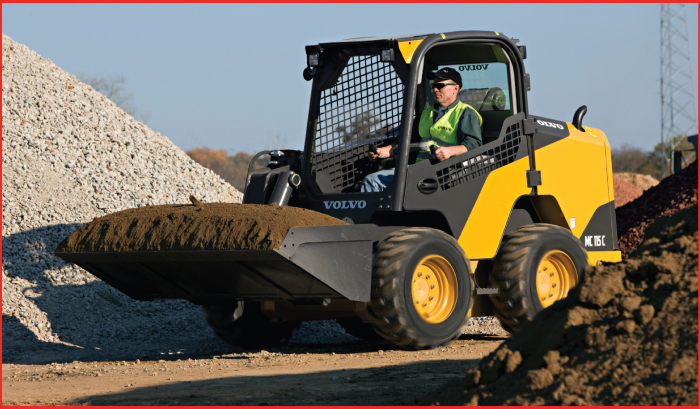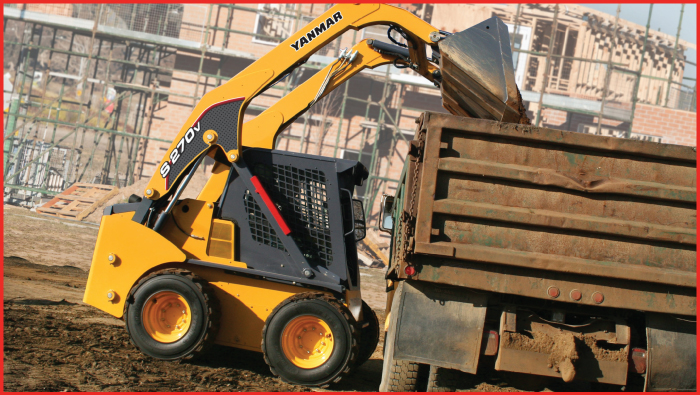Skid Steer Loader Section

In 2010, Case celebrated production of its 250,000 skid steer loader. Case has been among the world’s leading skid steer manufacturers since launching its skid steer line in 1969. Today, Case Construction Equipment offers nine Alpha Series skid steer models, which deliver superior horsepower, breakout force and operator comfort. Engines in the Alpha Series skid steers range from 46 to 90 hp, with rated operating capacities ranging from 1,300 lbs in the SR130 to 3,000 lbs in the SV300. Case Alpha Series skid steers deliver industry-leading bucket breakout force, says the company — up to 8,585 lbs.
The Alpha Series includes both radial- and vertical-lift models. The radial-lift machines (designated with an R in the model name), are engineered for digging, prying and pushing, while the vertical-lift models (designated with a V), excel in lift-and-carry applications. The Case Alpha Series includes six radial-lift skid steers, the SR130, SR150, SR175, SR200, SR220 and SR250, and three vertical-lift models, the SV185, SV250 and SV300.
Improved visibility, operator comfort and operator controls define the new Case Alpha Series machines. To begin, the skid steer cabs are 25 percent larger, the widest in the industry, says Case. They feature an ultra-narrow wire side-screen design that improves operator visibility. Plus, the glass surface provides 360-degree visibility. The Case Alpha Series cabs also provide a superior climate management system. The Alpha Series models feature larger fuel tanks. Thanks to improved fuel efficiency and new 16- to 25.5-gal fuel tanks, Case skids steers can easily run for eight to 10 hours without refueling.
The Case Power Stance chassis design features a longer wheelbase. This added stability means that operators will be able to lift and haul more material. Case skid steers feature a front/rear weight distribution of 30/70. Combined with the longer wheel base, this keeps the center of gravity from moving when the loader arms are raised. Electro-hydraulic switchable controls are available on all Alpha Series models. When two or more people operate the same machine, they can easily switch between control patterns based on preference.
Easy access to filters and engine fluids makes maintenance on the Case Alpha Series models a breeze. The regular maintenance points are grouped in one area so operators do not need to walk around the machine to find specific service points. Maintenance points, such as the radiator, fuel filter, battery terminals and engine oil fill, are easy to find at the rear of the machine. Case skid steers offer extreme versatility in dozens of applications. More than 70 attachments are available, including augers, rakes, grapples, pallet forks, brooms, dozer blades and hammers, to take on the toughest jobs.
Advice for Buyers
“When considering a skid steer for purchase, buy a machine that’s easy to maintain,” says Tim O’Brien, brand marketing manager with Case Construction Equipment. “Serviceability has become a big focus for equipment of all sizes. At Case, our philosophy is that the easier it is to perform service, the more likely it will get done. Also, work with a dealer you trust. You should feel that your dealer is part of your team — someone you can trust and rely on when the chips are down. Whether you need parts, service or support, you should be confident in your dealer’s commitment and ability to deliver whatever you need, whenever you need it.”
Contact Info
Case Construction Equipment
621 State St.
Racine, WI 53402
(866) 542-2736
Web: www.casece.com
Gehl began manufacturing agricultural implements in 1859, in West Bend, Wis. From those humble beginnings in a blacksmith shop, the Gehl brand has become a major force in the compact equipment industry worldwide. Today, Gehl’s headquarters remains in West Bend with a state-of-the-art research and design facility. Manufactured and assembled in Madison, S.D., Mustang skid steer models range from 24 to 71 hp, with rated operating capacities from 850 to 3,300 lbs.
Models in the small-frame family include the 1640E and 3640E skid loaders. These compact powerhouse units define productivity in confined areas, says Gehl. When configured with narrow tires, the 1640E is less than 36 in. in width, allowing the machine to access and work in restricted work environments.
The medium-frame family includes hard-working, durable 4240E, 4640E and 5240E models. These models feature exceptional strength relative to the most compact dimensions in the industry, notes Gehl. With engines rated from 46 to 68 hp and clearance circles (including bucket) from 69 to 80 in., these mighty little giants offer outstanding power in a compact frame.
Large-frame skid loaders round out Gehl’s range with the 5640E, 6640E, V270 and V330 models. The stalwart yet nimble 5640E and 6640E feature radial-lift path geometries, providing ideal performance in ground engaging applications. The V270 and V330 are equipped with vertical-lift path configurations, offering greater capability in lift-and-place applications. All Gehl skid loaders feature one of the broadest ranges of control patterns in the industry, allowing operators to do what they do best, how they do it best.
Versatility is ensured with standard auxiliary hydraulic flow for attachment power and optional high flow on larger models. The exclusive Gehl Powerview boom provides outstanding visibility to work areas along the side of the machine, as well as to the bucket. Extra-long wheelbase lengths provide smooth rides, while powerful and efficient Yanmar engines tirelessly deliver performance. Serviceability is not an afterthought, but thoughtfully designed into every skid loader, says Gehl. Service points are easily located, and ROPS structures tilt for full access when needed. Industry-leading safety is also standard on Gehl skid loaders, with Level 2 ROPS structures to protect operators. Additional features include ample grab handles and standard front and rear work lighting.
All models can be configured to individual preference though options such as fully enclosed cabs, hydraulic quick-attach units, two-speed motors, rear counterweights and much more.
Advice to Buyers
“There are many choices and options available to today’s compact equipment buyer,” says Sean Bifani, Gehl skid loader product manager. “The most important step in choosing a skid loader is to determine the application or applications in which it will be used. For maximum return on investment, it is essential to purchase a right-sized skid loader, which will complete immediate application needs, but will also allow room to grow. Your local dealer is an expert on providing knowledge and assistance and will be able to help narrow the field. Finally, request a demonstration to be sure a particular skid loader is the best match for applications.”
Contact Info
Gehl Co.
One Gehl Way
West Bend, WI 53090
(262) 334-9461
Email: info@gehl.com
Web: www.gehl.com
In 1993, JCB entered the skid steer market with the first mono-boom, side-entry skid steer, a design based on the company’s telescopic handlers. Over the years, JCB’s skid steer line has evolved, going from the Series I and Series II machines to today’s New Generation models. The New Generation line, initially introduced in November 2010, includes both large and small platform models offering vertical or radial lift. Today, JCB’s skid steers are designed to compete within the active North American marketplace, as well as worldwide.
JCB’s New Generation skid steer line includes 10 models ranging in operating capacity from 1,350 to 3,295 lbs and offering vertical or radial lift along with JCB’s unique “PowerBoom” design for enhanced visibility and safety. The newest models include the five small-platform models introduced in March 2012: the 135, 155, 175, 195 and 205. Currently, the large platform models — the 225, 260, 280, 300 and 330 — are popular due to their versatility on more complex projects that would otherwise require multiple dedicated machines, like a compact wheel loader or compact excavator. JCB offers over 30 attachment families that can help operators quickly complete a wide variety of tasks, from fence-post digging to snow removal and everything in between.
JCB’s most well-known and visually apparent safety feature is its PowerBoom — a single-arm boom that allows operators to safely enter the machine from a left-side entry door, clear of any potentially dangerous attachments or under an unsupported boom. The PowerBoom also makes it possible for these machines to operate without a rear torque tube, further increasing visibility from inside the cab to 270 degrees. Because operators are better able to view their surroundings, they gain confidence in their ability to operate the machine safely, further improving their productivity. In fact, the National Institute of Occupational Safety and Health (NIOSH) has actually recognized the many benefits of the PowerBoom side-entry design by rewriting their safety alert accordingly to exclude side-entry skid steers.
JCB skid steer cabs feature a suspension seat for maximum operator comfort and a sealed and pressurized cab, which prevents dust and dirt from entering the cab even on the grittiest of worksites. Servo controls help operators use the machines for longer periods of time without experiencing fatigue. This not only increases productivity, but also improves operator safety.
Advice to Buyers
“Choosing the right machine for the job is imperative,” says Ashby Graham, product specialist for JCB. “First, always get a machine large enough to lift your heaviest possible load. Also, consider what type of ground the machine will be working on. A wheeled skid steer is best for hard surfaces or harsh applications, while a compact track loader is better on wet or soft surfaces. Choose radial lift if you need more reach at the midpoint of the arc [loading flatbed trailers]. Choose vertical lift if you need more reach at the top of the arc [loading high-sided trucks or performing fork work]. Determine if there are other options available that might allow jobs to be completed faster or more easily.”
Contact Info
JCB North America
2000 Bamford Blvd.
Pooler, GA 31322
(912) 447-2000
Web: www.jcbvision.com
Since their inception in a small town in Minnesota at the dawn of the 1970s, skid steers have grown in stature as compact, efficient and valuable machines for worksites of all shapes and sizes. From construction to landscape to agriculture, industries have seen an increased need for smaller, more affordable, yet equally efficient machines to get the job done. Over the years, John Deere has improved each generation of skid steer from the original 24 Model to the current state-of-the-art lineup, which, despite their compact size, can handle tasks that were once reserved for larger equipment.
John Deere’s lineup of skid steers range in size and power from under 50 hp (313 and 315) to 50 to 75 hp (318D, 320D and 326D) to over 75 hp (328D and 332D). The under 50-hp models are lightweight and agile yet surprisingly powerful. They boast a 2.4-L turbocharged diesel engine that is EPA Interim Tier 4 certified. Features such as heavy-duty drive chains that never need adjustment, easy-to-fill large-capacity fuel tanks and self-cleaning, no-grease Quik-Tatch systems ensure it’s as easy to maintain as it is to run. Compatibility with many of the John Deere Worksite Pro attachments, such as forks, snowblades and rakes, allow for the use of the machine year round.
The 318D, 320D and 326D models incorporate a roomier operator station, a quieter pressurized cab with best-in-class visibility and a curved-glass, swing-out door. Operators also have a choice of numerous productivity-boosting options including electro-hydraulic joysticks with selectable control pattern and variable boom and bucket speed settings. Additional features include a highly efficient and easy-to-clean V-plenum cooling system and an electronic fuel-injected PowerTech E diesel engine that is EPA Interim Tier 4 certified. Grouped checkpoints, advanced diagnostics and wide-open access help speed servicing, minimize maintenance and lowering daily operating costs.
The 328D and 332D feature optimal weight distribution, low center of gravity, high ground clearance and long wheelbase to deliver superior stability. But getting there is only half the battle. These skid steers also excel at putting material in its place. The patented vertical-lift boom rises to the occasion, delivering exceptional lift height and reach, so you can do more with less effort.
Advice to Buyers
“Skid steers are great machines for contractors to consider if they’re starting a fleet or only looking to buy one piece of equipment,” says Gregg Zupancic, John Deere product marketing manager for skid steers and compact track loaders. “Attachments allow skid steers to become a Jack of all trades from dozing and trenching to mulching and compacting. The compact size allows for easy maneuverability around a variety of worksite landscapes and transportation is as easy as attaching a trailer to a pickup truck.”
Contact Info
John Deere
Worldwide Construction
& Forestry Div.
P.O. Box 8806
Moline, IL 61266
Web: www.johndeere.com
Mustang began in the 19th century as the Owatonna Mfg. Co. It started as an agricultural implement manufacturer and has since grown into a 21st century compact equipment powerhouse. Mustang is the second-oldest skid steer loader manufacturer in the world, building its first skid steer in 1965 — the Mustang Series 1000.
Mustang currently offers a broad range of 10 skid steer loader models. Raw power, a hallmark Mustang feature, is provided by high-output, high-torque Yanmar engines on every model. Superior ground-engaging capabilities and cycle-time performance are made possible by advanced, well-balanced hydraulic systems. Hundreds of attachments are easily interchangeable to expand the uses of a Mustang skid steer loader.
The Mustang 2012 and 2026 comprise the small-frame skid steer loader family. These radial-lift models offer substantial productivity relative to their super-compact size. The 2012 can be configured to a width of less than 36 in., providing access to restricted work environments. Size does not limit performance however, with a lift height of 96 in., and a rated operating capacity of 850 lbs. The equally strong and maneuverable 2026 has a rated operating capacity of 1,050 lbs.
The medium-frame Mustang skid steer models include the 2041, 2044, 2054 and 2056. With rated operated capacities ranging from 1,350 to 1,900 lbs, these radial-lift skid steer loaders are characterized by their outstanding performance in a compact frame. With engines rated between 46 and 68 hp, there is ample power to complete the most demanding of applications. Mustang 2076, 2086, 2700V and 3300V large-frame models complete the skid steer loader range. These powerful 71-hp workhorses are loaded with features that other manufacturers consider optional. Standard hydraulic self-leveling for performance and mechanical suspension seats for comfort are two examples of many. Mustang models 2076 and 2086 are radial-lift path models, while the 2700V and 3300V are vertical-lift path models.
All loaders are equipped with universal mechanical quick-attach plates, for accepting a comprehensive range of attachments. A hydraulic power attach is optional, to facilitate easy change-overs. Auxiliary hydraulic flow is standard, as is self-leveling on many models. Operator comfort and safety are provided through a standard Level 2 ROPS structure. The roomy, quiet operator area can be configured to operator preference through a variety of options, including heat and air conditioning.
Advice to Buyers
“When purchasing a skid steer loader, an equipment buyer should first determine the primary applications in which it will be used today and in the future,” says Sean Bifani, Mustang skid steer loader product manager. “From there, the equipment buyer should evaluate if the model’s lift height, rated capacity, size and available attachments will meet those needs. Ease of maintenance and comfort are also important factors to consider. Finally, make sure that you are comfortable with the level of service and support offered by the equipment dealer.”
Contact Info
Mustang
P.O. Box 179
West Bend, WI 53090
(262) 334-9461
Email: info@mustangmfg.com
Web: www.mustangmfg.com
New Holland began manufacturing skid steer loaders in 1972, barely a decade after the first four-wheel skid steer loader was invented (1960). Not only was New Holland one of the very first manufacturers of skid steer loaders, but it was the first to offer a fully enclosed operator station (ROPS) on every machine and a vertical-lift boom with its patented Super Boom style lift arms.
The new 200 Series from New Holland Construction marks the sixth generation of skid steer loaders for New Holland Construction and represents major advancements in technology, such as pattern switching electro-hydraulic controls. New Holland Construction has also taken the next step in operator comfort with the industry’s largest skid steer cab, according to the company, which provides superior visibility. Skid steer loaders represent the flagship product for New Holland Construction in North America. In 2012, New Holland Construction is celebrating the 40th anniversary of its skid steer loaders. The company is on track to manufacture its 250,000 unit.
New Holland Construction’s 200 Series skid steer loaders include seven models. The L218, L220, L223, L225 and L230 skid steer loaders feature the patented vertical-lift Super Boom design, delivering best-in-class forward dump height and reach. The 200 Series also includes two compact models — the L213 and L215 — which feature a radial-lift design, providing excellent digging performance.
With the Super Boom loader arm, New Holland skid steer loaders deliver superior lift and reach, says the company. Unlike competitive models, they can load material to the center of trucks, finishing jobs faster. The 53-degree dump angle on the 200 Series skid steer loaders is also best in class, says New Holland. This lets operators empty the bucket faster, increasing cycle times and productivity.
New Holland 200 Series skid steer loaders provide a superior working environment. The cab is one of the widest, most comfortable cabs in the industry, providing more head and foot room and offering superior visibility in critical zones. New Holland skid steer loaders give operators a 360-degree view of the jobsite. The new rear window provides best-in-class rear visibility, and the new lighting package delivers superior jobsite visibility.
Stability is an important part of being productive on the jobsite. The increased wheelbase on the New Holland 200 Series skid steer loaders allows operators to lift and haul more material, increasing productivity. Daily maintenance on the 200 Series skid steer loaders is quick and easy, says New Holland, so operators can stay on schedule. Regular ground-level maintenance points are grouped together and service can be performed by opening the rear engine compartment and door. For complete access to major components, the service technician only needs to remove two nuts and washers to tilt the cab forward. There is nothing to disconnect, and no special tools required. The new hydraulic system uses hydraulic oil, extending the service internal to 2,000 hours and significantly reducing the amount of disposed oil.
New Holland offers more than 50 skid steer loader attachments — including augers, brooms, dozer blades, grapples, hammers, pallet forks and rakes — to handle countless construction, landscaping or agricultural jobs. From material handling, digging, lifting and hammering to trenching, planing or drilling, operators can count on New Holland attachments to boost their productivity. For customers who frequently change attachments, the skid steer loaders feature a hydraulic heavy-duty coupler.
Contact Info
New Holland Construction
621 State St.
Racine, WI 53402
Web: www.newholland.com
Terex introduced its line of skid steer loaders, vertical-lift path and radius-lift path units, to complement its line of compact equipment in January 2011. Terex skid steer loaders are designed to be more productive, says the company, thanks to high ground clearances and rear angles of departure, high travel speeds, increased fuel capacities, strong tractive effort and mechanical-faced axle seals.
Terex offers a full line of skid steer loaders to match the needs of customers — four vertical-lift units and four radius-lift units, ranging from 1,500 to 3,000 lbs of rated operating capacity and 50 to 83 hp. The company’s wide offering gives customers loader options for most any job they might encounter. Terex says its skid steer loaders are built to get loading, picking and carrying, grading, back dragging or snow removal jobs done faster and more efficiently. Terex skid steer loaders have many unique features, including: 10 in. of ground clearance for pushing through rugged underfoot conditions; one-side daily service checks to make routine maintenance easy; mechanically faced axle seals to provide long life for the axles bearings; low tower design for excellent visibility; high tractive effort to push harder; joystick control for smooth and easy operation; tilt-up ROPS to accommodate maintenance checks; and an optional hydraulic quick-attach system.
To get more done on every jobsite, Terex offers performance-matched attachments for its skid steer loader line, including auger, backhoe, rotary broom, general purpose bucket, light-material bucket, multi-purpose bucket, dozer blade, pallet forks, power box rake, snow blade, snow blower, stump grinder, trencher, vibratory roller and the Loegering Eliminator rake. Each attachment comes standard with the necessary hydraulic lines and connectors or electric connections for a quick, easy fit.
Advice to Buyers
“The first thing contractors need to assess, whether renting or buying, is what tasks are they going to be performing with this unit,” says Jamie Wright, product manager at Terex Construction. “Then, they need to discuss what lift capacity, lift height and horsepower will be needed to perform those tasks. Also, they need to understand whether they would be more productive with a vertical-lift path or a radius-lift path unit. Once those factors have been determined, other attributes potential buyers will need to investigate are: how easy is the unit to maintain; what amount of hydraulic flow do they need to match their attachment needs; and will they need to use over-the-tire tracks on any of their projects?
“For renters, matching the size of the loader to the task is the most vital of decisions — renting a larger unit than needed can result in additional rental and fuel consumption costs, and the larger unit could be less productive because it may not be as efficient or as nimble at performing smaller tasks. Renting a unit that is too small for a job can overextend the limitations of the loader, which can result in unsafe operating conditions, and that may cost renters more in rental charges for extra days needed on the job to complete the task.”
Contact Info
Terex Corp.
8800 Rostin Rd.
Southaven, MS 38671
(662) 393-1800
Web: www.terexconstruction.com
In 2001, Volvo Construction Equipment acquired Scat Track and entered the North American market with five skid steer loader models in 2003. They ranged in operating capacity from 1,350 to 2,450 lbs and with hp ranges from 49.5 to 86 hp. In 2006, Volvo launched the B-Series models. In 2011, Volvo introduced the new C-Series skid steer loaders with a single loader arm design with three wheeled models. In May 2012, Volvo added four more models to the range for a total of seven skid steer loaders.
Featuring a unique single loader arm design, Volvo C-Series skid steer loaders deliver to customers a superior loading performance and durability found in a traditional skid steer design, along with the improved visibility, safety and enhanced cab access of a side-entry machine.
A full offering of radial- and vertical-lift skid steer loaders is available with seven models — MC60C, MC70C, MC85C, MC95C, MC110C, MC115C and MC135C. Rated operating capacities range from 1,350 to 3,000 lbs and gross engine power from 48 to 92 hp.
Due to the single loader tower arm design, cab access is easier and safer. Operators enter and exit the cab through a large, wide-opening side cab door. This eliminates the need for operators to climb onto and over the bucket or attachment. A bolt-on, non-slip step under the door increases safe entry and exit of the cab.
The loader arm provides strength and reliability and effectively distributes the load over the single loader arm, while the design also enhances visibility. Without the horizontal cross member found on most vertical-lift machines, operators experience excellent all-around, class-leading visibility. The cab also features a large top window for improved visibility during truck loading. This aids safety when operating in tight or congested areas.
Excellent lifting characteristics make the Volvo C-Series ideal for truck loading and a wide range of material handling applications. Each model features good tip height and reach, along with powerful lift capacity, making Volvo skid steer loaders highly efficient in repeated load-and-carry operations.
Unlike old format machines, the Volvo cab is sealed and pressurized, keeping out dust and noise and keeping operator fatigue levels down. More importantly, in an emergency exit situation these machines are much easier to get out of than traditional format skid steer loaders, as exit is through the large front window rather than a small rear window.
Volvo C-Series skid steer loaders offer improved service access through a forward-tilting cab and large rear compartment service door and all service and maintenance points are accessible through simple, safe means. The side entry and exit of the cab makes it possible for the operator to engage the loader arm support without the aid of a second person.
Advice to Buyers
“Before purchasing a new skid steer loader for your fleet, consider the benefits of buying a single-arm skid steer loader,” says John Comrie, Volvo CE competency manager for utility products. “The single-tower loader arm delivers the loading performance and durability of the traditional design, while improving operator safety, visibility and serviceability. Side entry and exit of the cab, even with the loader arm lifted, eliminates the need for the operator to climb over a muddy or slippery bucket or attachment.”
Contact Info
Volvo Construction Equipment
One Volvo Dr.
Asheville, NC 28803
(828) 650-2000
Web: www.volvoce.com/na
Since its inception in 1912, Yanmar’s core business has been the production of engines. Following the hugely successful introduction of the walk-behind dozer in 1967, Yanmar understood the need for even more versatile compact construction machinery and introduced one of the first mini excavators in 1968. After years of success with track technology and mini excavators, Yanmar will be adding a lineup of skid steer loaders and compact track loaders this summer.
Yanmar’s four new skid steer loaders will come with an unmatched combination of raw power and fuel-efficiency, says the company, so operators can handle whatever jobs need to get done. Ranging in size from 46 hp and a rated operating capacity of 1,650 lbs to 70.7 hp and a rated operating capacity of 2,700 lbs, these skid steers are as rugged as they are productive. With a wide range of attachment options, contractors will also enjoy the versatility to take on jobs that might normally require multiple machines.
Yanmar skid steer loaders provide stability with a cab forward design that gives great balance with a heavy-duty, one-piece steel frame. All of Yanmar’s skid steers allow the operator to maintain and service their equipment with the ability to rollback the cab and access all hydraulic pumps and drive motors. The first machine in Yanmar’s lineup is the S165R, with its 46-hp Yanmar diesel engine, rated operating capacity of 1,650 lbs, 116-in. height to hinge pin and 18 gpm of auxiliary hydraulic flow. With a Yanmar S165R skid steer, owners get the raw power and fuel efficiency to take on a wide variety of jobs other machines back down from. According to Yanmar, the unit is top of its class in hydraulic pump flow, dump height and compact dimensions.
Pros never know what they’re going to have to conquer in a day. With an ideal balance of power and performance, the Yanmar S190R skid steer loader boasts a 69-hp Yanmar diesel engine, rated operating capacity of 1,900 lbs, 121.5-in. height to hinge pin and 19 gpm of auxiliary hydraulic flow. With this unit, Yanmar notes, contractors can lift 2 tons into a truck or trailer and then get the job done quicker with top-of-the-class ground speed.
The Yanmar S220R skid steer is engineered with a 70.7-hp Yanmar diesel engine, rated operating capacity of 2,200 lbs, 123-in. height to hinge pin and 21.8 gpm of auxiliary hydraulic flow. This unit stacks up among the highest height to hinge pin and highest reach in its class, says Yanmar. With the company’s powerful, highly fuel-efficient diesel engines, pros can always keep a long day from becoming an expensive one. With a highest height to hinge pin in its class, the Yanmar S270V skid steer excels at lift-and-dump projects, utilizing a 70.7-hp Yanmar diesel engine, rated operating capacity of 2,700 lbs, 130-in. height to hinge pin and 21.8 gpm of auxiliary hydraulic flow. The S270V can load 2,700 lbs into just about anything. When operators are not lifting heavy loads real high, the S270V puts more attachments to use than pros have jobs to do, says Yanmar.
Advice to Buyers
“When purchasing a skid steer loader, look at the key design elements that will allow contractors to keep their equipment up and running for years with minimal downtime,” says Jake Jeffords, product marketing manager for Yanmar America Corp. “Precision manufacturing, common sense engineering and a proven fuel-efficient engine are important points to take into consideration when searching for the right machine.”
Contact Info
Yanmar America
101 International Pkwy.
Adairsville, GA 30103
(770) 877-9894
Web: www.us.yanmar.com


